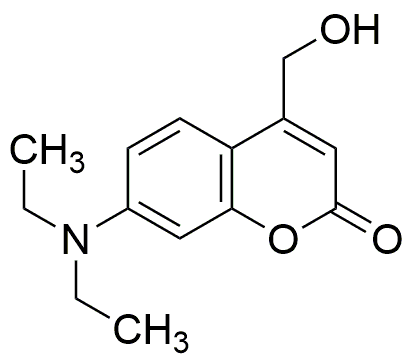7-(Diethylamino)-4-(hydroxymethyl)coumarin is widely utilized in research focused on:
- Fluorescent Probes: This compound is commonly used as a fluorescent marker in biological research, allowing scientists to visualize cellular processes with high sensitivity.
- Biochemical Assays: It serves as a substrate in enzyme assays, helping researchers measure enzyme activity and study metabolic pathways effectively.
- Drug Development: The compound's properties make it valuable in the pharmaceutical industry for developing new drugs, particularly in targeting specific biological pathways.
- Photodynamic Therapy: Its ability to absorb light makes it suitable for applications in photodynamic therapy, a treatment that uses light to activate photosensitizing agents in cancer treatment.
- Environmental Monitoring: This chemical is also applied in detecting pollutants in water sources, providing a reliable method for environmental scientists to assess water quality.
General Information
Properties
Safety and Regulations
Applications
7-(Diethylamino)-4-(hydroxymethyl)coumarin is widely utilized in research focused on:
- Fluorescent Probes: This compound is commonly used as a fluorescent marker in biological research, allowing scientists to visualize cellular processes with high sensitivity.
- Biochemical Assays: It serves as a substrate in enzyme assays, helping researchers measure enzyme activity and study metabolic pathways effectively.
- Drug Development: The compound's properties make it valuable in the pharmaceutical industry for developing new drugs, particularly in targeting specific biological pathways.
- Photodynamic Therapy: Its ability to absorb light makes it suitable for applications in photodynamic therapy, a treatment that uses light to activate photosensitizing agents in cancer treatment.
- Environmental Monitoring: This chemical is also applied in detecting pollutants in water sources, providing a reliable method for environmental scientists to assess water quality.
Documents
Safety Data Sheets (SDS)
The SDS provides comprehensive safety information on handling, storage, and disposal of the product.
Product Specification (PS)
The PS provides a comprehensive breakdown of the product’s properties, including chemical composition, physical state, purity, and storage requirements. It also details acceptable quality ranges and the product's intended applications.
Certificates of Analysis (COA)
Search for Certificates of Analysis (COA) by entering the products Lot Number. Lot and Batch Numbers can be found on a product’s label following the words ‘Lot’ or ‘Batch’.
Número de catálogo
Número de lote/lote
Certificates Of Origin (COO)
This COO confirms the country where the product was manufactured, and also details the materials and components used in it and whether it is derived from natural, synthetic, or other specific sources. This certificate may be required for customs, trade, and regulatory compliance.
Número de catálogo
Número de lote/lote
Safety Data Sheets (SDS)
The SDS provides comprehensive safety information on handling, storage, and disposal of the product.
DownloadProduct Specification (PS)
The PS provides a comprehensive breakdown of the product’s properties, including chemical composition, physical state, purity, and storage requirements. It also details acceptable quality ranges and the product's intended applications.
DownloadCertificates of Analysis (COA)
Search for Certificates of Analysis (COA) by entering the products Lot Number. Lot and Batch Numbers can be found on a product’s label following the words ‘Lot’ or ‘Batch’.
Número de catálogo
Número de lote/lote
Certificates Of Origin (COO)
This COO confirms the country where the product was manufactured, and also details the materials and components used in it and whether it is derived from natural, synthetic, or other specific sources. This certificate may be required for customs, trade, and regulatory compliance.


